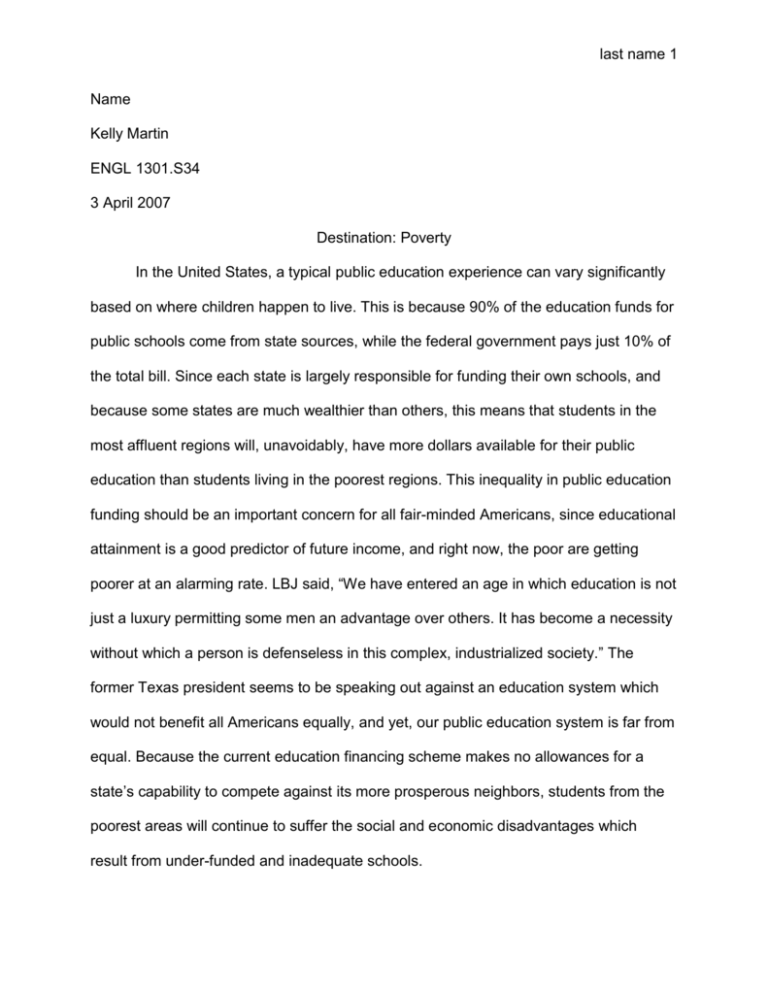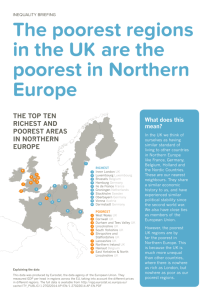edessay1 - professormartin
advertisement

last name 1 Name Kelly Martin ENGL 1301.S34 3 April 2007 Destination: Poverty In the United States, a typical public education experience can vary significantly based on where children happen to live. This is because 90% of the education funds for public schools come from state sources, while the federal government pays just 10% of the total bill. Since each state is largely responsible for funding their own schools, and because some states are much wealthier than others, this means that students in the most affluent regions will, unavoidably, have more dollars available for their public education than students living in the poorest regions. This inequality in public education funding should be an important concern for all fair-minded Americans, since educational attainment is a good predictor of future income, and right now, the poor are getting poorer at an alarming rate. LBJ said, “We have entered an age in which education is not just a luxury permitting some men an advantage over others. It has become a necessity without which a person is defenseless in this complex, industrialized society.” The former Texas president seems to be speaking out against an education system which would not benefit all Americans equally, and yet, our public education system is far from equal. Because the current education financing scheme makes no allowances for a state’s capability to compete against its more prosperous neighbors, students from the poorest areas will continue to suffer the social and economic disadvantages which result from under-funded and inadequate schools. last name 2 An excellent example of the inherent unfairness experienced by students when school dollars are allocated based on geography alone is the case of Edgewood ISD v. Kirby. In this case, funds for public schools in Texas were determined solely on the amount of property tax dollars collected within each of over 1000 financially independent school districts. In 1984, the Edgewood Independent School District, one of the poorest in Texas, filed a lawsuit alleging that the practice of using local property tax revenue as the primary source of a district’s education funding violated several educational provisions mandated by the state’s Constitution. Principally, the suit challenged the fairness of a state education system which forced citizens of the impoverished Edgewood ISD to pay property taxes twice as high as a neighboring school district, while collecting just half as much revenue. Specifically, the Edgewood ISD could provide only $3000 per student, whereas the nearby wealthy school district easily collected more than $7000 per student, at just half the tax rate. The Texas Supreme Court ultimately ruled in favor of Edgewood’s complaint and directed the legislature to reform school finance in a way that would distribute school funds equally between districts. Fortunately, today the most economically disadvantaged students in Texas can receive a substantially better education. Yet, despite this important victory, in most states, including Texas, a meaningful spending discrepancy persists. According to a report published by The Education Trust, a prominent nonprofit education advocacy group, as of 2004, states continued to spend an average of $1300 less on their poorest students (Trust 7). Perhaps, however, the greatest educational inequality issue in America today, is the enormous disadvantage borne by public school children from the poorest states. last name 3 Since 90% of public education dollars are the responsibility of the states themselves, students are subjected to dramatically different educational opportunities based their state’s ability to generate school funds. For example, in a national comparison of perpupil spending, Vermont spends more than $9400 per student, while Mississippi collects just under $5400 (Trust 4). This difference of $4000 per-pupil, represents an annual loss of $100,000 for a 25-student classroom, while a Mississippi high school for 1,500 students will lose a whopping $6 million each year! It seems clear that children in America’s poorest states are statistically assured that they will be unable compete for the highest-skilled jobs without a major reform in the distribution of public education money. There are several reasons why resolving this type of education inequality should be a priority for all of us. The most important being, that now more than any other time in our nation’s history, education inequality directly translates into income inequality. Several alarming statistics demonstrate this point. According to an article in US News & World Report, billionaire Mortimer Zuckerman reports that the most affluent 15% of all Americans now own 85% of the nation’s personal wealth, while the bottom 50% of Americans have less than 3% of that amount. He further explains that over the last 25 years, the total value of goods and services produced by American workers each year (aka GDP), has risen by more than 60%, and yet, when wages are adjusted for inflation, the typical American worker now earns less than they did 25 years ago! Worse still, Zuckerman warns, this trend toward economic inequality is accelerating. By looking at the same 25-year period as a ratio between the richest and poorest 20% of Americans, the relative gap in wealth has widened from 7:1 in 1980, to almost 10:1 today. Why is last name 4 this happening? According to Mr. Zuckerman, “The stratification in American incomes is a reflection of the stratification in education.” The combination of technology and globalization is eliminating many low-skilled American jobs because of foreign competition and automation. This has created a financial advantage for workers who possess “intellectual skills” such as a college degree (Zuckerman). Since low education levels are causing the salaries of average Americans to fall, and the divide between the rich and the poor is growing dramatically, it is now more important than ever that public education dollars are distributed in a socially responsible way. One often overlooked result of under funding schools is that these students are less likely to graduate than those who have benefited from the best schools. A conspicuous relationship emerges when comparing the previous state spending data, with high school graduation rates as reported by the US Department of Education. For example, Vermont, which is among the top in per-student funding, is also near the top in graduation rates, at 84%, while Mississippi, which is near the bottom in spending, also has one of the lowest graduation rates, at just 63%. Although exceptions to this rule exist, it follows that schools which can afford programs aimed at preventing dropouts, will have better graduation results. Graduation rates are important because the effect of not receiving a high school diploma has serious consequences. This leads to another important reason why it is in our collective interest to embrace educational equality; the effects of receiving a good education directly translate into social and economic benefits for both the student, and for the community as a whole. According to authors Sandy Baum and Kathleen Payea, the benefits of a high school diploma cover a broad range of categories, including: last name 5 higher rates of employment, higher income, greater tax contributions, fewer medical costs, lower crime levels, increased civic participation, and reduced welfare burdens (7). Ironically, most of these benefits simply result when people are not forced into financial distress. Victor Hugo said, "He who opens a school door, closes a prison." I think he correctly identifies the two major causes of crime, ignorance and need, both of which are ameliorated by a good education. In a recent study sponsored by Columbia University which examined a group of 700,000 high school dropouts, it was revealed that each additional graduate would generate $209,000 of community benefits and approximately $200,000 in additional personal income (Levin et al. 3, 9). This means that for every high school dropout, society will lose $209,000 as a result of welfare and unemployment costs, criminal activity, medical burdens, and lost tax contributions because high school dropouts also suffer because they are likely to experience lower pay, higher unemployment, greater incarceration rates, and added health problems (3). Not graduating high school is literally a lose-lose situation. The good news however, is that this same study identifies several educational improvements which can greatly increase high school graduation rates. More importantly, this educational reform more than pays for itself through the student’s added tax contributions alone! For example, a 16% higher graduation rate can be expected by implementing the First Things First high school reform program, while spending just $60,000 per additional graduate (6-7). In other words, for an investment of $60,000, society would get a return of $209,000 per child, while the student would earn another $200,000 as well! Because the link between poverty and reduced education spending has been previously established, the added connection between lower last name 6 graduation rate and lower income potential, demonstrates another way in which America’s poorest citizens are unjustly prevented from escaping their economic bonds. The situation for economically disadvantaged states like Mississippi, reminds me of those financially-strapped families in the Edgewood ISD v. Kirby case. The problem is fundamentally the same, but instead of poor school districts struggling to afford adequate schools, it’s now poor states who are expected to compete with their wealthy neighbors. For some reason, the Federal government seems unconcerned about the children who are economically victimized by this discriminatory arrangement. Of course it doesn’t have to be this way; just as most states have taken enormous strides towards education spending equality, now is the time for the Federal government to do the same. Harvard Professor, Derek Bok said, “If you think education is expensive, try ignorance." This quote sums up my argument nicely. As I have tried to show, the money required to greatly improve the education of America’s poorest children, would in the process, reduce demands on social safety-net programs like: welfare, unemployment, and healthcare, relieve pressure on the exploding criminal justice system, and generate much larger amounts of tax revenue. Therefore, I propose that we create a Federal program to supplement the funding deficits for states which are demonstrably unable to fund competitively equipped school systems. Although the ultimate goal of this program would be to eliminate the economic discrimination which perpetuates the growing income inequality in America’s poorest regions, as I have discussed, this program would in fact help all Americans. Until public school funding is allocated to all states in a fair way, a large number of America’s children will be destined for poverty simply because they happen to live in the wrong place. last name 7 Works Cited Baum, Sandy, and Kathleen Payea. "Education Pays 2004: The Benefits of Higher Education for Individuals and Society." College Board. 2005. 26 Mar. 2007. <www.collegeboard.com/prod_downloads/press/cost04/EducationPays2004.pdf>. Levin, Henry, Clive Belfield, Peter Muennig, and Cecilia Rouse. "The Costs and Benefits of an Excellent Education for All of America's Children." Center for Benefit-Cost Studies of Education . 7 Jan. 2007. Columbia University. 26 Mar. 2007. Path: http://www.cbcse.org/pages/cost-benefit-studies.php. Liu, Goodwin, Ross Wiener, and Eli Pristoop. "Funding Gaps 2006." The Education Trust. 20 Dec. 2006. 26 Mar. 2007. Path: http://www2.edtrust.org/EdTrust/Press+Room/Funding+Gap+2006.htm. Seastrom, L. Hoffman, C. Chapman, and R. Stillwell. "Public High School Graduation Rates by State." The National Center for Education Statistics. 2005. U.S. Department of Education. 28 Mar. 2007. <http://nces.ed.gov/programs/coe/2006/section3/table.asp?tableID=486#top>. Zuckerman, Mortimer B. "Rich Man, Poor Man." U.S. News & World Report 12 June 2006: 72+. MasterFILE Premier. Collin County Community College Lib., Plano, TX.23 March 2007. <http://search.ebscohost.com>.





